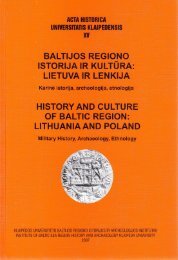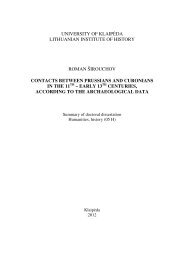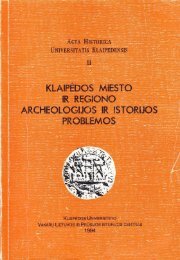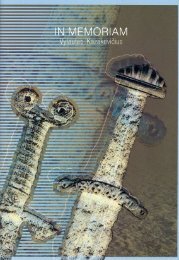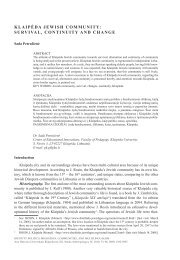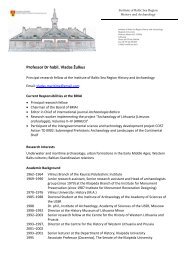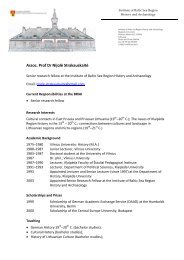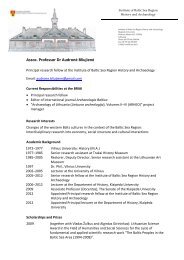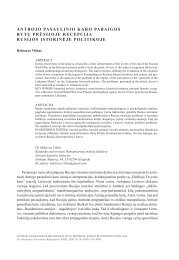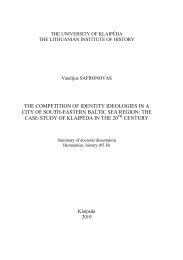See summary of dissertation in English - Baltijos regiono istorijos ir ...
See summary of dissertation in English - Baltijos regiono istorijos ir ...
See summary of dissertation in English - Baltijos regiono istorijos ir ...
You also want an ePaper? Increase the reach of your titles
YUMPU automatically turns print PDFs into web optimized ePapers that Google loves.
deed, the number <strong>of</strong> economically organised manor estates considerably<br />
<strong>in</strong>creased <strong>in</strong> the last decade <strong>of</strong> the 16 th century but the same cannot<br />
be told about the area <strong>of</strong> arable land. The dynamics <strong>of</strong> change <strong>of</strong> arable<br />
land showed that the arable land was on the fall<strong>in</strong>g scale <strong>in</strong> the<br />
manors <strong>in</strong> the course <strong>of</strong> the 16 th century.<br />
Apart from traditional crops, pease and buckwheat show<strong>in</strong>g a<br />
rather significant scope <strong>of</strong> cultivation played a rather important role <strong>in</strong><br />
Samogitia. However, like the cultures cultivated at vegetable and fruit<br />
gardens at that time, they were mostly used for domestic needs. It<br />
should be noted that the<strong>ir</strong> range little differed from the crop cultures<br />
cultivated <strong>in</strong> the neighbour<strong>in</strong>g Polish lands at that time.<br />
Hay production played a significant rule <strong>in</strong> crop production. Its<br />
production was closely related with another branch <strong>of</strong> farm<strong>in</strong>g actively<br />
cultivated <strong>in</strong> manors, i.e. stock-rais<strong>in</strong>g. It is <strong>in</strong>terest<strong>in</strong>g to note<br />
that the <strong>in</strong>ventories testify<strong>in</strong>g the importance <strong>of</strong> hay provide the data<br />
that some manors could cultivate and prepare hay for sell<strong>in</strong>g, which<br />
was a well-known and rather widely spread phenomenon <strong>in</strong> Central<br />
Europe at that time.<br />
Stock-rais<strong>in</strong>g was another equally important branch <strong>of</strong> manorial<br />
farm<strong>in</strong>g. At Samogitian manors, stock-rais<strong>in</strong>g was developed <strong>in</strong> four<br />
ma<strong>in</strong> d<strong>ir</strong>ections: horse-breed<strong>in</strong>g, cattle breed<strong>in</strong>g, small livestock<br />
(sheep, goats, pigs) and poultry farm<strong>in</strong>g. In the general livestock<br />
structure (despite poultry) horse-breed<strong>in</strong>g accounted for 10%, cattle<br />
breed<strong>in</strong>g – 35%, small livestock – 55% (among them sheep made up<br />
27%, goats – 5% and pigs – 23%). Such data show that apart from the<br />
use <strong>of</strong> livestock for agricultural labour, meat and milk production<br />
played the important role as well. Unfortunately, we may not tell what<br />
pr<strong>of</strong>its were generated from this production; nevertheless, the attempted<br />
<strong>in</strong>crease <strong>in</strong> this type <strong>of</strong> production by enhanc<strong>in</strong>g the traits <strong>of</strong><br />
livestock was recorded. The study showed that such attempts manifested<br />
slightly earlier than it has been thought to this day.<br />
Even though the manor was supplied with poultry and the<strong>ir</strong> products<br />
through the dues and services paid by peasants, poultry farm<strong>in</strong>g<br />
was cultivated as well. The research has shown that geese accounted<br />
for as much as 59% <strong>in</strong> poultry farm<strong>in</strong>g, followed by chickens (38%)<br />
46



